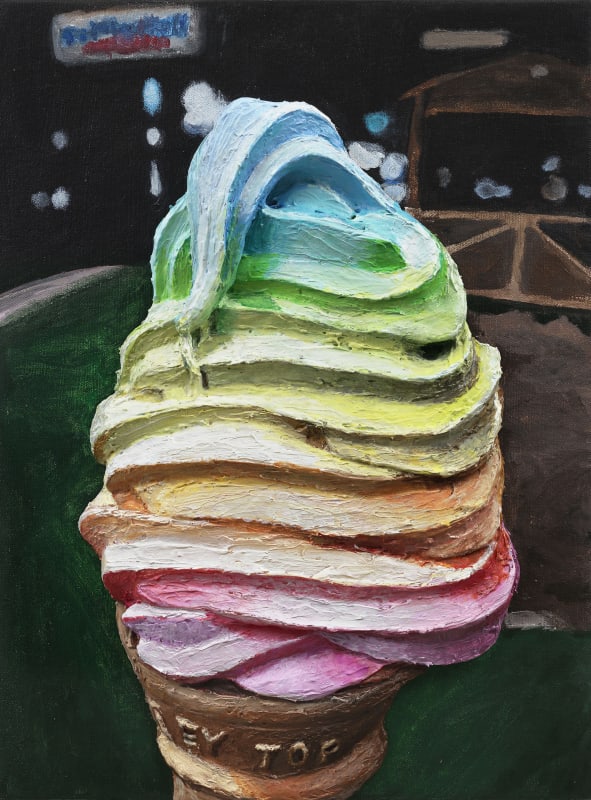BY CHARLOTTE KENT
The lighting for Gina Beavers’s exhibit The Life I Deserve is Instagram perfect. That seems only fitting for paintings based on social media posts and aware that they will return there as #art #museum #artselfie or even, in a potential throwback to 2015, #museumselfie. The artist’s #Foodporn series from 2014 gets particular attention, though the newer series based on makeup tutorials had some snapping pics as well. All this begs the question, what are we looking at?
The first of the three rooms concentrates on square format paintings of food images that Beavers found online. The works glisten from a distance, redolent of the slick foodie pictures that people love to post. Up close, they are suddenly three-dimensional, the acrylic paint mixed with foam, wood, and other materials—texture and gross materiality breaching the presumptions of a flat plane surface. The large rectangular format of a painting displaying a grilled steak, It’s a Beauty (2019), ironically doesn’t attract quite like Local Pasteurized Beef (2014) or Local White Dorper Lamb (2013), where the smaller, lurid chops bulge on top of each other, the white fat as thick and matte as the table on which the meat sits. The paintings often look better afar than up close. Near, the material no longer sustains the illusion; they become less glossy, less delectable. The matte acrylic paint and the lines of the brushstrokes transform the images plotted, produced, and posted to cultivate envy and desire into lumpy thingness. That is likely the point and why issues of ugliness abound in discussing Beavers’s work. The paint highlights the texture of these pictures of our lives.
Based on a viral image from 2011, Van Gogh’s Starry Night as Rendered in Bacon (2016) is rendered now in acrylic, the swirls a thick impasto. Framed by the archway into the middle room, it draws people trying to make sense of what they are seeing. The small room includes four works referencing art history like Mona Lisa Nail (2015) of a hand displaying the head of Mona Lisa on the left ring finger. In a wry gesture, Beavers reminds us that painting spans from the priceless works of artists in famous museums to the carefully crafted masterworks of nail art professionals using the slenderest brushes in the more select salons. Watercolor Tray Palette (2018) enlarges your typical watercolor set-up and materializes like sculpture out of its wall hanging but, even more interestingly, alludes to a medium not in evidence within the show. The palette is marvelously out of place as watercolor won’t provide the texture of acrylic nor the gloss of oil painting to approximate the scintillating seductions of a visual culture based on social media. And yet, one is keen suddenly to see something that could be so different.
The final room includes large scale works more directly about the body and displayed with curatorial humor. LipBalls 3 (2018) depicts a mouth with assorted sports balls billowing off the lips. Next to it, Crotch Shots at the Getty Villa (2014) frames five crotches in a classic Instagram layout. One large square statuesque crotch in the lower left corner is topped by two more protrusions of male genitalia, with an additional two on the right. Smaller paintings along another wall poke fun, like You Won’t Believe (2015) a disconcerting zipper closing or opening a mouth, depending on your perspective. Camel Flage (2014) riffs on The Rolling Stones’s classic 1971 album Sticky Fingers (an older square-format visual reference) by switching out the bulging man package for a woman’s crotch squeezed by a pair of black jeans. Sex may be everywhere, but there’s nothing sexy here. Humor, with a heavy dose of ridicule and irony, however, proliferate.
Tag Yourself (2016) reveals Beavers’s love of painting as she captures the blue light of a late night perfectly. The body parts are hard to connect, but the sleek color cast along the edge of the nude bodies hints at the screen and media off to the side. In this painting, Beavers goes beyond the burlesque of our social media infatuation and reveals the pathos of this moment when screens are present even in the most intimate settings. There’s more for Beavers to do now that we are largely aware of the all-consuming force of social media and these works can carve out a space for viewers to question how we see art and image, texture and plane, object and idea, as well as museum and social media platform. As we chuckle at Beavers’s playfulness, we also pause in observation. One thing that painting offers during this period when we largely scroll, swipe and scan is the chance to slow down, to look a little more closely, to stop—not simply for a selfie but for self-reflection.


